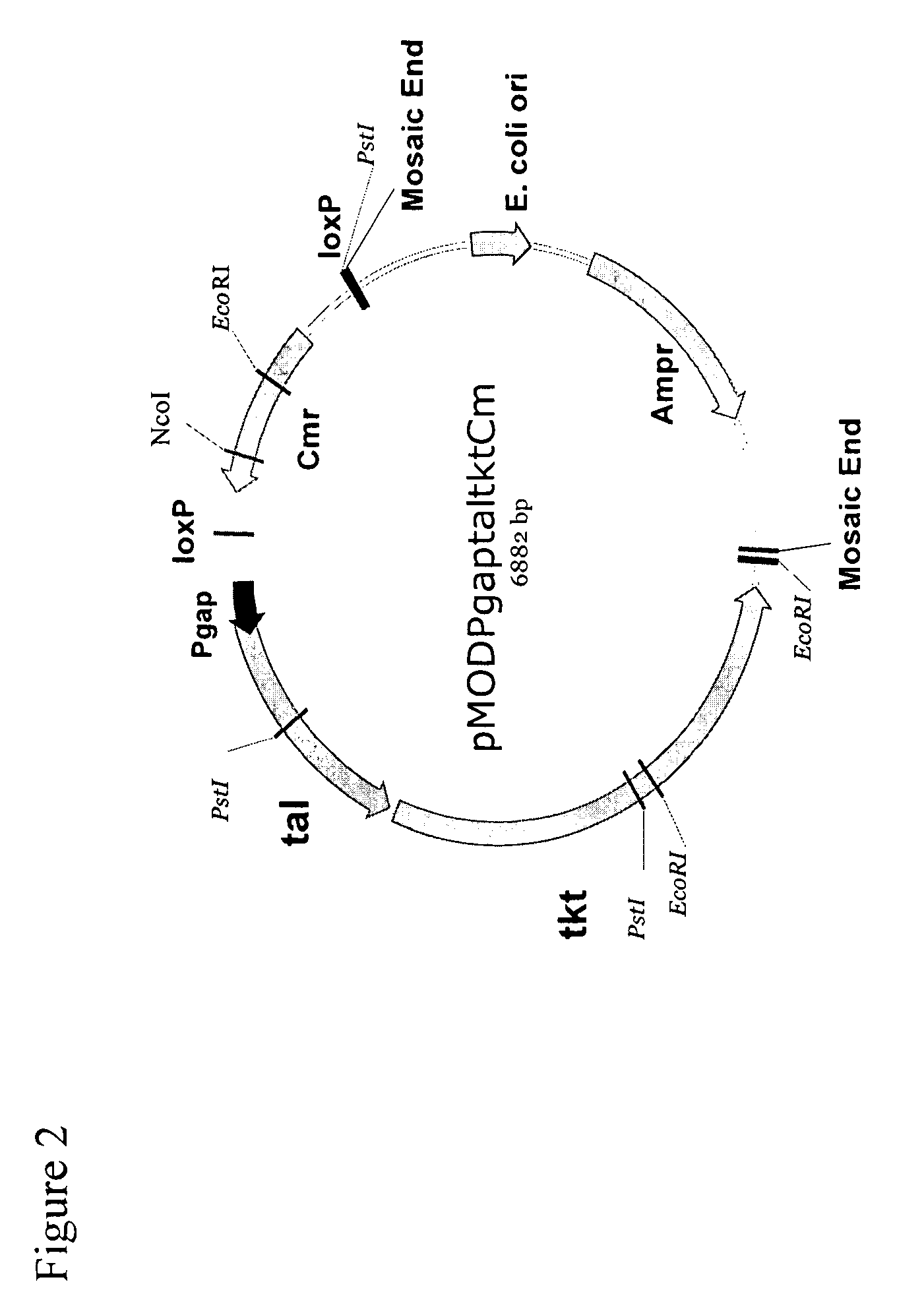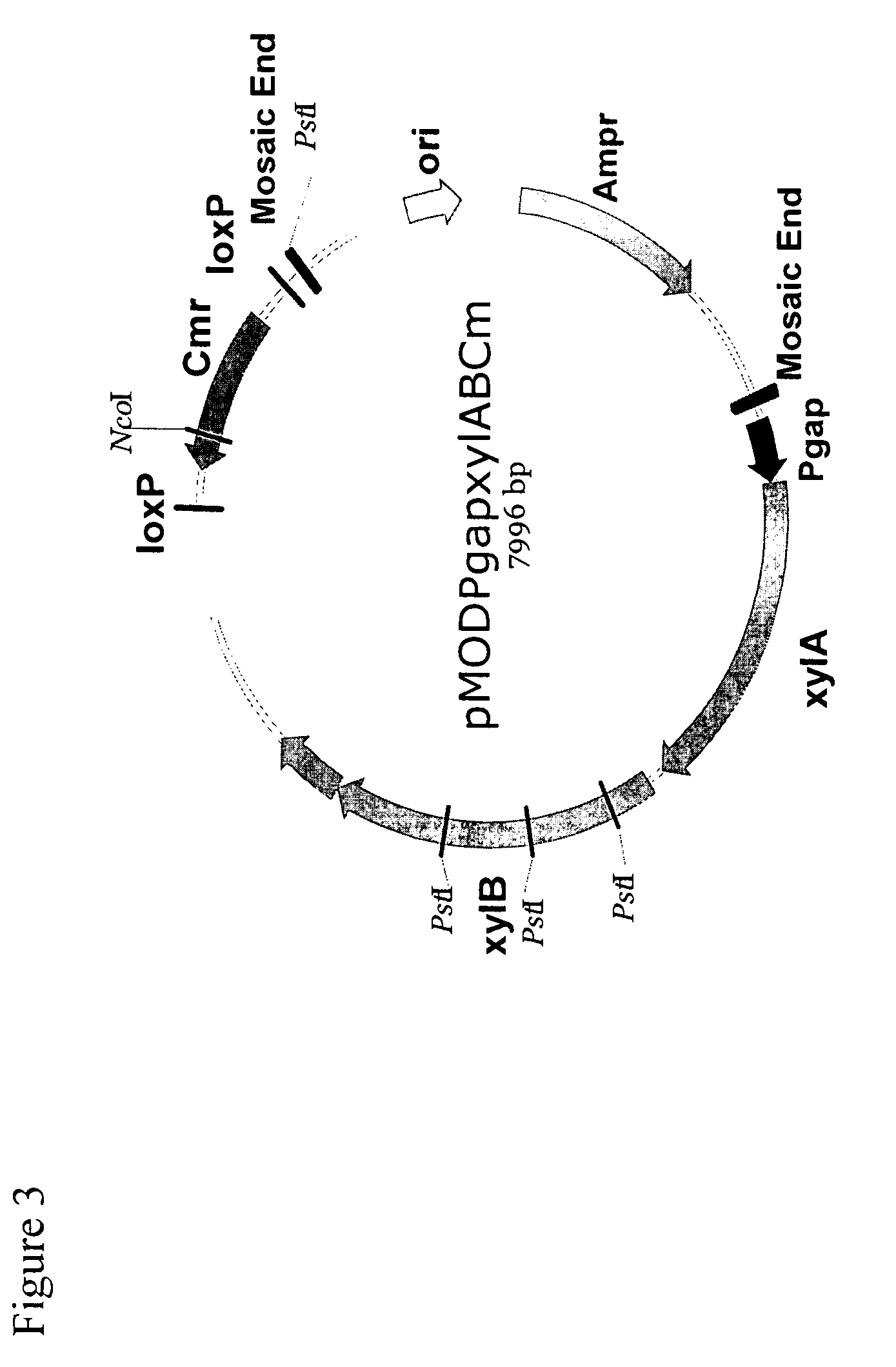Ethanol production in fermentation of mixed sugars containing xylose
a technology of ethanol production and mixed sugar, which is applied in the field of microbiology and genetic engineering, can solve the problems of toxic to cells, limited ethanol yield, and inability to achieve the theoretical ethanol yield,
- Summary
- Abstract
- Description
- Claims
- Application Information
AI Technical Summary
Benefits of technology
Problems solved by technology
Method used
Image
Examples
example 1
Construction of ZW658, a Xylose-fermenting Zymomonas mobilis Strain
[0128]ZW658 was constructed by integrating two operons, PgapxylAB and Pgaptaltkt, containing four xylose-utilizing genes encoding xylose isomerase, xylulokinase, transaldolase and transketolase, into the genome of ZW1 (ATCC #31821) via sequential transposition events, and followed by adaptation on selective media containing xylose. Previously, a xylose-fermenting Zymomonas mobilis strain called 8b was constructed, as described in United States Patent Application 20030162271, by integrating the two operons PgapxylAxylB and Penotaltkt, along with selectable antibiotic markers, into the genome of Zymomonas mobilis 5C via a combination of homologous recombination and transposon approaches followed by adaptation and NTG mutagenesis. In the preparation of ZW658, transposition (Epicentre's EZ::Tn in vitro transposition system) was used, as opposed to site specific homologous recombination, because this approach offers the a...
example 2
Fermentation Evaluation of Top Improved Xylose-utilization Strains at 37° C
[0146]The following example illustrates the fermentation performance of the improved xylose-utilizing Zymomonas strain ZW658 under fermentation conditions that mimic the sugar concentrations and the acetic acid level expected in a biomass hydrolysate. Strain ZW658 was inoculated into fermentors containing RM medium supplemented with 10% glucose (RMG10%), 8% xylose (RMX8%), 10% glucose+8% xylose (RMGX10%8%) and 10% glucose+8% xylose+0.6% acetic acid (RMGXAc10%8%0.6%), respectively. All fermentations were conducted in Sixfors with 300 ml media at 150 rpm, pH5.5 and 37° C. Nitrogen was purged through the media in the fermentors overnight and stopped right before inoculation. No nitrogen was purged during the fermentation. Inocula for the fermentation were prepared with RMGX (10%,4%) at 37° C. in shake flasks (150 rpm) after reviving of the working stocks in RMG5%. Strain 8b was used as a control under the same c...
example 3
Ethanol Production by Strain ZW658 Grown on High Concentration Glucose or Xylose in the Presence and Absence of Sorbitol
[0148]In four sterilized 125 ml Erlenmeyer culture flasks (Cat. No. 30180-036, VWR International, USA), 10 ml of ZW658 strain seed culture at OD600 of approximately 5 was inoculated into each flask with 100 ml of aqueous solution containing 10 g / L yeast extract (YE), 2 g / L KH2PO4, 4 g / L KHCO3. Before inoculation, the first flask also contained 200 g / L glucose and 20 mM sorbitol, comparing to the second flask with 200 g / L glucose only. The third flask contained 200 g / L xylose and 20 mM sorbitol, comparing to the fourth flask with 200 g / L xylose only. After inoculation, sugar concentrations were diluted to about 180 g / L. Initial pH was adjusted to 5.5 with 4 NH3PO4 solution. Mixing speed was set at 150 rpm. Fermentation was conducted at 33° C. and pH was not controlled. Samples were taken periodically. Samples were filtered through 0.22 micron filters, and the filtra...
PUM
| Property | Measurement | Unit |
|---|---|---|
| concentrations | aaaaa | aaaaa |
| concentrations | aaaaa | aaaaa |
| temperature | aaaaa | aaaaa |
Abstract
Description
Claims
Application Information
 Login to View More
Login to View More - R&D
- Intellectual Property
- Life Sciences
- Materials
- Tech Scout
- Unparalleled Data Quality
- Higher Quality Content
- 60% Fewer Hallucinations
Browse by: Latest US Patents, China's latest patents, Technical Efficacy Thesaurus, Application Domain, Technology Topic, Popular Technical Reports.
© 2025 PatSnap. All rights reserved.Legal|Privacy policy|Modern Slavery Act Transparency Statement|Sitemap|About US| Contact US: help@patsnap.com



